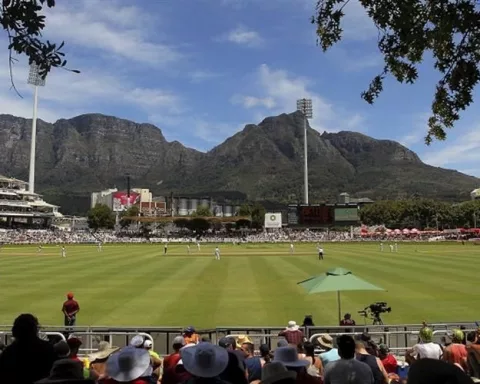The second Test match between South Africa and India at Newlands was the shortest completed Test in cricket history, ending in just one and a half days due to an unsatisfactory pitch. The International Cricket Council deemed the pitch unsatisfactory and players struggled to execute their shots effectively due to the unpredictable bouncing of the ball. The incident has prompted discussions about the importance of pitch conditions and their impact on the game’s result, with contrasting viewpoints on maintaining fair competition and home advantage.
The Infamous Newlands Pitch
The second Test match between South Africa and India at Newlands ended in just one and a half days, setting a new record for the shortest completed Test in cricket history. The pitch has been deemed “unsatisfactory” by the ICC, with players struggling to execute their shots effectively due to its unpredictable and inconsistent bouncing behavior. The incident has prompted discussions about the importance of pitch conditions and their impact on the game’s result.
The cricket fraternity is currently embroiled in a contentious debate following the extraordinary end to the second Test match between South Africa’s Proteas and India at Newlands. The game reached a shocking conclusion just a day and a half post commencement, setting a new record for the shortest completed Test in cricket history. This unexpected development has heightened concerns of cricket aficionados, who are already expressing dismay over the alleged decline of Test cricket.
The Infamous Newlands Pitch
The pitch at Newlands has been brought into the spotlight as a key influencer in this astonishing series of events. The International Cricket Council (ICC) has deemed the pitch “unsatisfactory,” tagging it with a demerit point. ICC match referee Chris Broad elaborated that the pitch posed a considerable difficulty for batters. The unpredictable and inconsistent bouncing of the ball during the match complicated the players’ attempts to execute their shots effectively. The unusual bouncing behavior resulted in several players being hit on their gloves and a multitude of wickets tumbling.
South Africa’s Take on the Issue
The seriousness of the incident was underlined by Proteas coach Shukri Conrad, who staunchly defended the widely criticized pitch and its caretaker, groundsman Braam Mong. Conrad showed empathy for the groundsman’s predicament, acknowledging the challenges they encountered due to the windy conditions in Cape Town. Nonetheless, he asserted that it was crucial for the groundsmen to prepare a regular pitch for the players, particularly the newcomers to international cricket. These new players needed an opportunity to learn their craft unhindered by an excessively-prepared pitch.
India’s Perspective on the Pitch
India’s captain Rohit Sharma, on the contrary, didn’t hesitate to articulate his opinion on the Newlands pitch. Far from expressing dissatisfaction, he was eager to embrace the challenge it posed. But, he also highlighted an apparent double standard in the critique of pitches. He drew attention to the differing responses to bouncy pitches like that at Newlands and the slow, spin-friendly pitches in India. The latter often face criticism for generating ‘puff of dust,’ and are occasionally labelled as ‘unplayable’.
Sharma’s remarks bring out the contrasting viewpoints on the issue. One side argues for maintaining the sport’s integrity through high-quality pitches that ensure a fair competition between the bat and ball. Conversely, some see the pitches as an extension of the ‘home advantage,’ where the host team can leverage the conditions their players are more familiar with.
The Broader Implications for Cricket
The uproar over the Newlands Test highlights the significance of pitch conditions in cricket. The pitch isn’t just the platform where the game unfolds but also a dynamic component that can significantly sway the game’s result. It serves as a reminder that cricket is a sport deeply reliant on the interaction of various factors – player prowess, game plan, weather conditions, and, indeed, the pitch itself.
However, the incident at Newlands also prompts questions about the extent of this interaction. Should pitches be permitted to have such a dominating impact on the game’s result? Or should there be more stringent regulations to guarantee a level playing field?
While these questions might remain unresolved for now, the episode serves as a powerful reminder of cricket’s unpredictability and sophistication. It has revitalized debates about the sport’s key components and will continue to dominate cricketing discussions for some time. The Newlands pitch may have been subpar, but the debate it has triggered is unquestionably contributing to the broader discourse around the sport and its future.
1. What led to the Newlands Test becoming the shortest completed Test in cricket history?
The Newlands Test became the shortest completed Test in cricket history due to an unsatisfactory pitch that made it difficult for players to execute their shots effectively. The ball had unpredictable and inconsistent bouncing behavior, resulting in several players being hit on their gloves and a multitude of wickets tumbling.
2. What is the International Cricket Council’s (ICC) take on the pitch at Newlands?
The ICC has deemed the Newlands pitch “unsatisfactory” and has tagged it with a demerit point. ICC match referee Chris Broad elaborated that the pitch posed a considerable difficulty for batters.
3. What is South Africa’s stance on the issue?
Proteas coach Shukri Conrad defended the pitch and its caretaker, groundsman Braam Mong. Conrad acknowledged the challenges groundsmen encounter due to the windy conditions in Cape Town. Nonetheless, he asserted that it was crucial for groundsmen to prepare a regular pitch for the players, particularly the newcomers to international cricket.
4. What is India’s perspective on the pitch at Newlands?
India’s captain Rohit Sharma was eager to embrace the challenge posed by the Newlands pitch. However, he highlighted an apparent double standard in the critique of pitches. He drew attention to the differing responses to bouncy pitches like that at Newlands and the slow, spin-friendly pitches in India.
5. What are the broader implications of the controversy at Newlands?
The incident at Newlands highlights the significance of pitch conditions in cricket and prompts questions about the extent of their impact on the game’s result. It serves as a reminder that cricket is a sport deeply reliant on the interaction of various factors – player prowess, game plan, weather conditions, and, indeed, the pitch itself.
6. What is the debate around cricket pitches?
The debate around cricket pitches centers around maintaining the sport’s integrity through high-quality pitches that ensure fair competition between the bat and ball, versus pitches being an extension of the “home advantage,” where the host team can leverage the conditions their players are more familiar with. The Newlands Test has revitalized debates about the sport’s key components and will continue to dominate cricketing discussions for some time.












